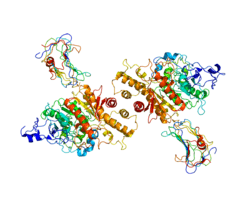NLGN4X
Neuroligin-4, X-linked is a protein that in humans is encoded by the NLGN4X gene.[3][4]
This gene encodes a member of the neuroligin family of neuronal cell surface proteins. Neuroligins may act as splice site-specific ligands for beta-neurexins and may be involved in the formation and remodeling of central nervous system synapses. The encoded protein interacts with discs, large (Drosophila) homolog 4 (DLG4). Mutations in this gene have been associated with autism and Asperger syndrome. Two transcript variants encoding the same protein have been identified for this gene.[4]
References
- 1 2 3 GRCh38: Ensembl release 89: ENSG00000146938 - Ensembl, May 2017
- ↑ "Human PubMed Reference:".
- ↑ Nagase T, Ishikawa K, Kikuno R, Hirosawa M, Nomura N, Ohara O (Jan 2000). "Prediction of the coding sequences of unidentified human genes. XV. The complete sequences of 100 new cDNA clones from brain which code for large proteins in vitro". DNA Res. 6 (5): 337–45. doi:10.1093/dnares/6.5.337. PMID 10574462.
- 1 2 "Entrez Gene: NLGN4X neuroligin 4, X-linked".
Further reading
- Cantallops I, Cline HT (2000). "Synapse formation: if it looks like a duck and quacks like a duck ...". Curr. Biol. 10 (17): R620–3. doi:10.1016/S0960-9822(00)00663-1. PMID 10996085.
- Irie M, Hata Y, Takeuchi M, et al. (1997). "Binding of neuroligins to PSD-95". Science. 277 (5331): 1511–5. doi:10.1126/science.277.5331.1511. PMID 9278515.
- Bolliger MF, Frei K, Winterhalter KH, Gloor SM (2001). "Identification of a novel neuroligin in humans which binds to PSD-95 and has a widespread expression". Biochem. J. 356 (Pt 2): 581–8. doi:10.1042/0264-6021:3560581. PMC 1221872. PMID 11368788.
- Strausberg RL, Feingold EA, Grouse LH, et al. (2003). "Generation and initial analysis of more than 15,000 full-length human and mouse cDNA sequences". Proc. Natl. Acad. Sci. U.S.A. 99 (26): 16899–903. doi:10.1073/pnas.242603899. PMC 139241. PMID 12477932.
- Jamain S, Quach H, Betancur C, et al. (2003). "Mutations of the X-linked genes encoding neuroligins NLGN3 and NLGN4 are associated with autism". Nat. Genet. 34 (1): 27–9. doi:10.1038/ng1136. PMC 1925054. PMID 12669065.
- Clark HF, Gurney AL, Abaya E, et al. (2003). "The Secreted Protein Discovery Initiative (SPDI), a Large-Scale Effort to Identify Novel Human Secreted and Transmembrane Proteins: A Bioinformatics Assessment". Genome Res. 13 (10): 2265–70. doi:10.1101/gr.1293003. PMC 403697. PMID 12975309.
- Ota T, Suzuki Y, Nishikawa T, et al. (2004). "Complete sequencing and characterization of 21,243 full-length human cDNAs". Nat. Genet. 36 (1): 40–5. doi:10.1038/ng1285. PMID 14702039.
- Laumonnier F, Bonnet-Brilhault F, Gomot M, et al. (2004). "X-Linked Mental Retardation and Autism Are Associated with a Mutation in the NLGN4 Gene, a Member of the Neuroligin Family". Am. J. Hum. Genet. 74 (3): 552–7. doi:10.1086/382137. PMC 1182268. PMID 14963808.
- Zhang Z, Henzel WJ (2005). "Signal peptide prediction based on analysis of experimentally verified cleavage sites". Protein Sci. 13 (10): 2819–24. doi:10.1110/ps.04682504. PMC 2286551. PMID 15340161.
- Gerhard DS, Wagner L, Feingold EA, et al. (2004). "The Status, Quality, and Expansion of the NIH Full-Length cDNA Project: The Mammalian Gene Collection (MGC)". Genome Res. 14 (10B): 2121–7. doi:10.1101/gr.2596504. PMC 528928. PMID 15489334.
- Yan J, Oliveira G, Coutinho A, et al. (2005). "Analysis of the neuroligin 3 and 4 genes in autism and other neuropsychiatric patients". Mol. Psychiatry. 10 (4): 329–32. doi:10.1038/sj.mp.4001629. PMID 15622415.
- Blasi F, Bacchelli E, Pesaresi G, et al. (2006). "Absence of coding mutations in the X-linked genes neuroligin 3 and neuroligin 4 in individuals with autism from the IMGSAC collection". Am. J. Med. Genet. B Neuropsychiatr. Genet. 141 (3): 220–1. doi:10.1002/ajmg.b.30287. PMID 16508939.
- Talebizadeh Z, Lam DY, Theodoro MF, et al. (2006). "Novel splice isoforms for NLGN3 and NLGN4 with possible implications in autism". J. Med. Genet. 43 (5): e21. doi:10.1136/jmg.2005.036897. PMC 2564526. PMID 16648374.
- Yamakawa H, Oyama S, Mitsuhashi H, et al. (2007). "Neuroligins 3 and 4X interact with syntrophin-gamma2, and the interactions are affected by autism-related mutations". Biochem. Biophys. Res. Commun. 355 (1): 41–6. doi:10.1016/j.bbrc.2007.01.127. PMID 17292328.
This article is issued from
Wikipedia.
The text is licensed under Creative Commons - Attribution - Sharealike.
Additional terms may apply for the media files.



